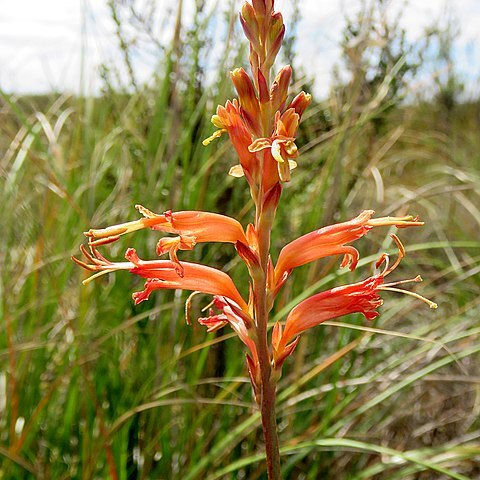Plants 250-600 mm high. Corm 30-60 mm diam.; tunics of coarse fibres, with a long collar. Stem flexed outward at ground level then erect, unbranched or with 1, rarely 2 short branches, 3-6 mm diam. Basal leaves 3 to 6, in a fan with longitudinally folded, overlapping sheaths, green or drying at flowering, blades lanceolate, 150-400 x 8-20 mm, acute or acuminate, not subpetiolate below, with 3 to 5(6) veins; cauline leaves 3 to 5, lower 1 or 2 lanceolate or subulate, rarely up to 100 mm long, upper 1 to 3 reduced, bract-or scale-like. Spike moderately to densely ± 7-to 40-flowered, 50-200 mm long; bracts brown or reddish, dry and leathery, ovate or ovate-lanceolate, outer 8-15 mm long, acute or acuminate, inner slightly longer. Flowers usually dull pink or pinkish red, rarely bright red, the tube often yellowish, lower tepals often with dark median line between white bands, unscented; perianth tube dimorphic, sharply bent, 25-40 mm long, slender in lower 8-25 mm, widening at bend into cylindric upper part, lower part much shorter to ± as long as upper part; tepals unequal, all suberect to spreading, later reflexed, arising at same level or lower arising progressively up to 5 mm beyond upper, all narrowly spathulate to oblanceolate-spathulate, obtuse, narrowed or clawed in lower half, dorsal tepal largest, 22-30 x 4-7 mm, others subequal or upper lateral slightly smaller, (12-)15-24 x 3-5 mm. Filaments arcuate, later recurved, 30-40 mm long; anthers 5-8 mm long, yellow, subacute or shortly apiculate with apiculus up to 1.5 mm long. Style 45-60 mm long, dividing opposite lower half of anthers, branches 3-4 mm long, often bifid. Capsules ellipsoid to subglobose, usually strongly inflated, 20-40 x 15-20 mm. Seeds 4-6 mm long, shortly winged on angles.
More
Perennial herb, geophyte, 0.35-0.90 m high; corm depressed-globose, tunics of coarse fibres usually up to neck; stem simple. Bracts green, becoming dark reddish brown when dry. Leaves lanceolate to linear, 3-6-veined. Inflorescence a ± distichous, dense spike; flowers salmon-pink to red, lower tepals dark-streaked; perianth tube 25-30 mm long; tepals unequal, dorsal largest. Stamens arcuate; filaments 32-40 mm long. Flowering time Nov.-Apr.
Cormous geophyte to 90 cm. Leaves lanceolate to linear, 3-6-veined. Flowers tubular, red to yellowish pink, dorsal tepal largest, arising below lower, lower tepals often with dark streaks, tube 25-30 cm.

